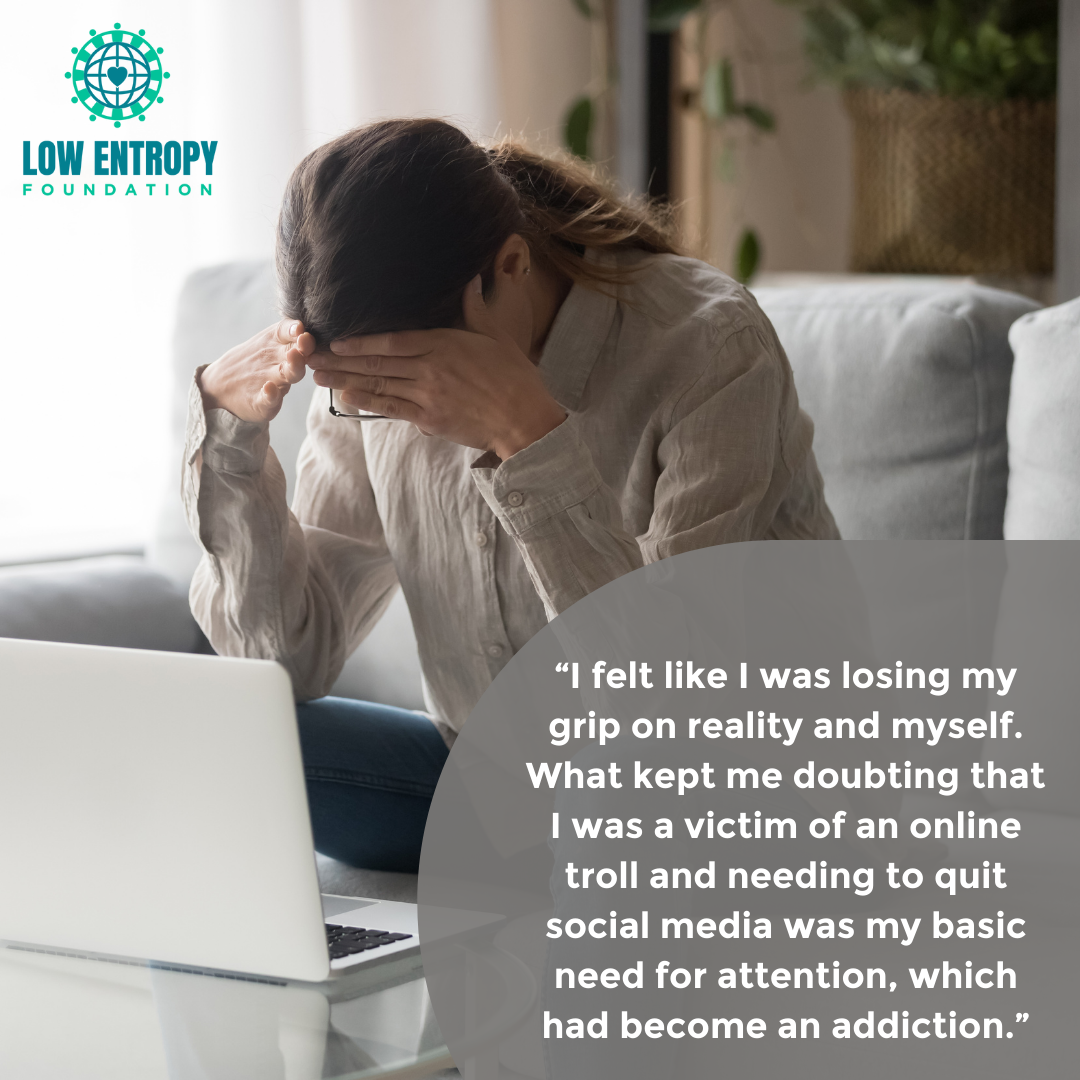Jane Doe, Low Entropy Volunteer Writer
Please note that this piece discusses online abuse and contains a brief reference to suicidal ideation.
As a latecomer to social media in 2014, I decided to join it like many other artists — in order to promote my work. I was of the belief that social media would provide me with community and a helpful network from which to draw inspiration. Everyone seemed to have their own handles, domains and followers. I was enthusiastic to join the vast online world, and share my own vision of things: paintings, photographs and words of wisdom, after living in seclusion. But a few months into my online adventure, my enthusiasm began to wane. I was unfamiliar with social media jargon and protocols of engagement, including such things as frequency of posting content and commenting. I didn’t understand the concept of what was considered “private” or “public,” as many were posting publicly only. As such, I soon began to attract unwanted attention. I was unfamiliar with the term “trolling” and what it meant, but I rapidly began to experience what many people at some point have experienced online: harassment by an anonymous troll.
Up until then, my only reference for anonymity had been masked protesters fighting for a cause, comic book characters like V in V for Vendetta, or balaclava-ed bank robbers. Even if I had never been the victim of road rage, I could relate to the circumstantial anonymity of a road rage incident, the result of social disconnection from others within the bubble of a car.
But this was different. Unlike a road rage incident, I could not identify my interlocutors (or URLs) — whether it was one or 10 different trolls. Unlike a bank robber, I could not identify their motives. Trying to decipher who and how many “they” were, and their goals, began to take up my precious time. I forgot why I was on social media. Time spent creating my site and producing artwork was soon replaced with arguing and playing cat-and-mouse games with pseudonyms and out-of-focus profile pics. The interactions gradually became more sinister, until the troll began to send me suicidal ideations and other unmentionable imagery.
After one year, I began to suspect that the troll was someone I knew. I saw correlations between our interactions online and seeing an acquaintance on the street outside my home, in my local supermarket and passing me in traffic. There was information that the troll knew about me that I had not revealed. The worst part about this though, was that l had not one shred of tangible proof that the troll was this acquaintance, and paranoia set in.
A turning point came when I realized that what I assumed was my growing confusion and paranoia was, in fact, rooted in reality — there were too many real-life “coincidences” for it to be paranoia. It came to matter less to me what this troll’s motives or identity was than how they were making me feel. I felt like I was losing my grip on reality and myself. What kept me doubting that I was a victim of an online troll and needing to quit social media was my basic need for attention, which had become an addiction.
This situation eventually took a bad but helpful turn when the police got involved, which forced me back into social isolation. I took a two-year absence from social media, during which time I began writing poetry. Discovering poetry allowed me to develop better critical judgment — not just in detecting manipulation, but in understanding myself. I began to enter writing competitions and took advantage of free online courses, which led me to enroll in university. I had swapped my addiction to taking selfies and interacting with shady accounts, with the therapy of writing short stories and free-verse poetry.
Such is the dilemma for many users of social media: questioning whether its benefits outweigh its dangers. Though my experience with anonymity on social media was negative, the opposite can be true. In sharing this experience, I have chosen anonymity to protect myself. Anonymity in the public domain protects freedom of speech and the vulnerable. It can facilitate truth-telling that, under normal exposed conditions, may not be possible. Without anonymity, I could never have relayed this experience for fear of revealing too much, or of reinvigorating a troll’s interest. Jane Does throughout history have been able to come forward with their stories, oftentimes more painful than this. Even if my experiences with social media have been terrifying at times, I recognise that there is a place for public anonymity, especially in an imperfect world.
The ease with which false accounts can be created and mistruths spread over the internet at the click of a mouse makes social media highly problematic. Its risk-free rewards benefit both the good and ill-intentioned. As such, it’s every user’s responsibility to themselves to be educated about the pitfalls and benefits of being online.
I hope never to be the target of a road rage incident some day, but if I am, the precautions to take when dealing with an angry driver are uncannily similar to those applicable to social media users: remain in your car, stay calm, avoid eye contact, keep your window up and, most importantly, keep your eyes focused on your destination.
—
Leave your thoughts for us in the comments below — better yet, start up a dialogue with the Low Entropy community in person at a Conscious Connections meeting or online at our community site. You can also follow us on Facebook, Instagram, TikTok, Twitter and YouTube to stay up-to-date with Low Entropy news!







